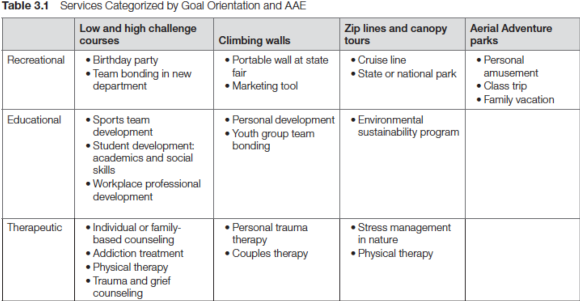Goal orientations of aerial adventure experiences
This is an excerpt from Aerial Adventure Environments With HKPropel Access by Elizabeth A Speelman,Mark Wagstaff,Scott H Jordan,Kathy Haras.
Potential participants who come to AAEs typically have a particular goal in mind, whether or not they can articulate it. They are seeking an experience that will present something new or change their lives. They want to have a fun experience with friends, learn about the natural environment, improve their group's ability to work with each other, or build confidence in their own abilities. In fact, two participants who come to the same program may not have the same expectations of themselves for the experience.
The goal orientation of a given experience relates to its intended outcome—the primary objective or takeaway of the participant's experience. Three broad goal orientations of AAEs are recreation, education, and therapy. Individuals who participate in a recreational experience do so in their free time; their intention may be to experience pleasure, personal fulfillment, or positive engagement with nature. Educational experiences cover a wide variety of intentional opportunities for growth and development in individuals or groups; participants focus on developing their skills, knowledge, and dispositions. Therapeutic experiences are intended to enhance participants' physical, social, and emotional well-being; these experiences typically serve as one among several kinds of treatment employed with an individual. Although each of these goal orientations can be defined, even experiences within the same category don't always align. Therefore, these categories should be viewed as existing on a continuum. For example, due to their distinctive intentions, a birthday party at an aerial adventure park creates a much different recreational experience than a family outing to spend quality time with each other on a canopy tour. In addition, participants in an aerial adventure experience may have outcomes beyond those intended; for instance, an experience might be educational by design yet still enable participants to feel a sense of personal fulfillment.
Figure 3.2 shows a layered continuum model for aerial adventure experiences. This model is an adaptation of Wagstaff's (2016) challenge course program continuum. Each category—recreational, educational, therapeutic—includes a continuum that overlaps to some degree with the others. In addition, a layering effect occurs with outcomes that may not be the primary outcome. This layering is more likely to occur when moving from recreational to therapeutic than in the reverse; in other words, recreational outcomes are more likely to be experienced by participants in educational or therapeutic activities than therapeutic outcomes are to be experienced during recreational events. The model also depicts several other continuums as we move from recreational to educational to therapeutic experiences. For example, the focus shifts from the activity to the individual. That is, a purely recreational experience is more about completing the novel task, such as participating in a new zip line or free-fall jump. In contrast, a therapeutic experience is more about changes in the individual resulting from the experience; in this case, choosing one zip line over another makes less difference in the outcome. Finally, the model includes two continuums related to staff engagement in the process of the experience. This aspect will be discussed further as we explore each of the goal orientations.
The differences described here are determined by program outcomes rather than participants. For example, a school-based program is not necessarily bound to an educational program. Certainly, group members could participate in an educational program to learn about the environment or to learn how to stand up for each other to prevent bullying, but they could also participate in a recreational program to celebrate upcoming graduates. Thus the fact that it is a school-based group does not in itself define the aerial adventure experience.
Table 3.1 provides examples of services provided in each of the goal orientations for the six types of AAEs as defined in chapter 1. Due to significant overlap, low and high challenge courses are grouped together, as are zip lines and canopy tours. Again, the categories are defined here in terms of outcomes. We will explore each of these goal orientations further because each type comes with its own implications, both for program managers and (most important) for participant's expectations.

SHOP

Get the latest insights with regular newsletters, plus periodic product information and special insider offers.
JOIN NOW


